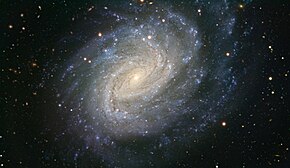NGC 1187 is a barred spiral galaxy located about 60 million light-years away in the constellation of Eridanus. It was discovered on December 9, 1784 by the astronomer William Herschel.[4]
| NGC 1187 | |
|---|---|
 NGC 1187 imaged by ESO’s Very Large Telescope.[1] | |
| Observation data (J2000 epoch) | |
| Constellation | Eridanus[1] |
| Right ascension | 03h 02m 37.40s[2] |
| Declination | −22° 52′ 02.0″[2] |
| Redshift | 0.004657[2] |
| Heliocentric radial velocity | 1393 km/s[2] |
| Distance | 60 million ly[1] |
| Apparent magnitude (V) | 11.4[2] |
| Characteristics | |
| Type | SB(r)c[3] |
| Apparent size (V) | 5.370′ x 3.630′[2] |
| Other designations | |
| HIPASS J0302-22, MCG -04-08-016, UGCA 49, AM 0300-230, IRAS 03003-2303, NVSS J030237-225200, 6dFGS gJ030237.6-225202, PSCz Q03003-2303, DUGRS 480-001, LEDA 11479, ESO 480-023, 2MASX J03023758-2252017, SGC 030024-2303.8, MBG 03004-2303. | |
NGC 1187 has hosted two supernova explosions since the 1980s. In October 1982, the first supernova seen in NGC 1187 — SN 1982R, a type I,[5] was discovered at La Silla Observatory[1] and, in 2007, the amateur astronomer Berto Monard in South Africa spotted another supernova in this galaxy — SN 2007Y, a type Ib/c.[6][7]
Gallery
edit-
DSS image of NGC 1187.
-
NGC 1187 by 2MASS
-
NGC 1187 by Pan-STARRS
-
NGC 1187 and ESO 480-20 (top, next to the star HD 18967) with the legacy surveys
References
edit- ^ a b c d "A Blue Whirlpool in The River". ESO Press Release. Retrieved 1 August 2012.
- ^ a b c d e f "Search results for NGC 1187". Astronomical Database. SIMBAD. Retrieved 1 August 2012.
- ^ "Results for object NGC 1187 (NGC 1187)". NASA/IPAC Extragalactic Database. California Institute of Technology. Retrieved 2021-02-21.
- ^ Seligman, Courtney. "New General Catalogue objects: NGC 1150 - 1199". cseligman.com. Retrieved 2021-02-21.
- ^ "SN 1982R | Transient Name Server". www.wis-tns.org. Retrieved 2021-03-13.
- ^ Stritzinger, Maximilian; Mazzali, Paolo; Phillips, Mark M.; Immler, Stefan; Soderberg, Alicia; Sollerman, Jesper; Boldt, Luis; Braithwaite, Jonathan; Brown, Peter; Burns, Christopher R.; Contreras, Carlos; Covarrubias, Ricardo; Folatelli, Gaston; Freedman, Wendy L.; Gonzalez, Sergio; Hamuy, Mario; Krzeminski, Wojtek; Madore, Barry F.; Milne, Peter; Morrell, Nidia; Persson, S. E.; Roth, Miguel; Smith, Mathew; Suntzeff, Nicholas B. (2009). "The He-rich core-collapse supernova 2007Y: Observations from X-ray to Radio Wavelengths". The Astrophysical Journal. 696 (1): 713–728. arXiv:0902.0609. Bibcode:2009ApJ...696..713S. doi:10.1088/0004-637X/696/1/713. S2CID 14139520.
- ^ "Bright Supernovae - 2007". www.rochesterastronomy.org. Retrieved 2021-03-13.
External links
edit- Media related to NGC 1187 at Wikimedia Commons